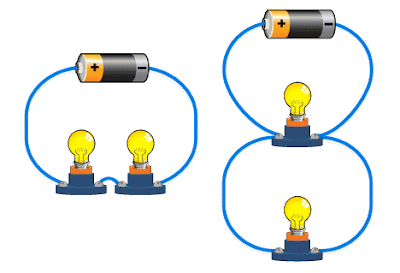Circuits 2 - Series and Parallel circuits

OK, so about regular circuits: The images represent SERIES CIRCUITS and PARALLEL CIRCUITS. In a series circuit, the current is constant and is set by the total resistance of the circuit (the sum of the resistors). If you remove one resistor (or light bulb, as in the first image), the current stops . If the resistors were identical bulbs, having more bulbs would result in dimmer bulbs, since the battery voltage is distributed among them. Note that the sum of the voltages "over" the bulbs is equal to the total voltage provided by the battery (give or take some minor losses). Identical bulbs (or resistors) have identical voltages "over" them - 3 identical bulbs connected to a 9-V battery would have roughly 3-V each over them. In parallel circuits, current has multiple paths to take, so the total resistance of the circuit is actually LESS than if the resistors were alone or in series with other resistors - see details belo...






